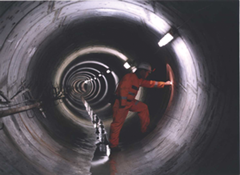Water scarcity
 Shortages of water are expected to pose problems at home and abroad. Stephen Dineen reports.
Shortages of water are expected to pose problems at home and abroad. Stephen Dineen reports.
Policy-makers are aware that Ireland is expected to grow in population and economy, and that the climate will change.
Climate change’s effect on Ireland’s water supply has been documented in state reports and discussion documents in recent years. A 2009 EPA report on climate change impacts for Ireland predicted drier summers, which will make resources more vulnerable in the east and south-east of the country especially. There will be domestic water shortages and reduced supply to industry as well as restricted extraction from river systems, leading to the need to irrigate certain high value crops.
Economic development will put a strain on resources. A 2008 Forfás report on water and waste water services for enterprise found that as well as current problems with supply capacity in some cities and towns, industry will experience pressure from water scarcity in the future. Current and planned infrastructural development, it stated, will not be sufficient for expected increases in demand in certain urban centres in the medium term.
Industrial demand on a county’s water supply was illustrated in a Dáil debate last May when Kildare North’s Anthony Lawlor referred to the “huge water requirements” of the Intel plant in Kildare, and said increased water supplies will be needed in his constituency to cater for Intel’s current plant expansion.
Water leakage is a major problem, with an average of 41 per cent of treated water unaccounted for by councils (with most councils between 30-60 per cent).
Projected population increases, if realised, will also increase demand for water. In 2008 the CSO forecast that the population could rise by nearly 1.5 million by 2021, and by a further 1.4 million between 2021 and 2041.
Globally, water scarcity is nothing new. Water use has been growing at more than twice the rate of population increase in the last century. The UN estimates that 700 million people in 43 countries are experiencing water scarcity, and that by 2025 there will be a 50 per cent increase in water withdrawals in developing countries and 18 per cent in developed countries.
A 2009 report by consultants McKinsey for the 2030 Water Resources Group concluded: “In the world of water resources, economic data is insufficient, management is often opaque, and stakeholders are insufficiently linked.” The result: many countries struggling to shape implementable, fact-based water policies, with water resources facing “inefficient allocation and poor investment patterns because investors lack a consistent basis for economically rational decision-making.”
The report predicted that by 2030, under an average economic growth scenario with no water efficiency gains assumed, global requirements will grow by 40 per cent from the current accessible, reliable supply (from 4,500 billion to 6,900 billion m³). It suggested three different kinds of solutions that are necessary, feasible and financially beneficial: the technical solutions of increasing supply and improving water productivity, and a change in economic activities.
Ireland is investing in technical solutions such as supply infrastructure (€371 million in water and wastewater services capital investment in 2012) and improved productivity through measures such as water metering (expected to begin by 2014).
While technical options can close a country’s “base-case” water deficit, McKinsey highlighted that technical solutions must be compared to additional options “to shift the set of underlying economic activities away from the most water-intensive ones recognising that growth in energy, agriculture, and manufacturing have real implications for the water budgets of river basins and countries.”
In its public consultation on reform of the water sector, the Department of the Environment, Community and Local Government states that “Ireland needs to exploit its competitive advantages and to attract more water intensive industries.”





